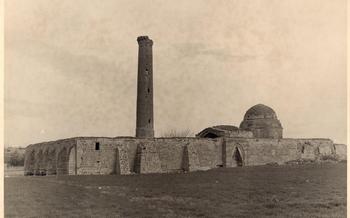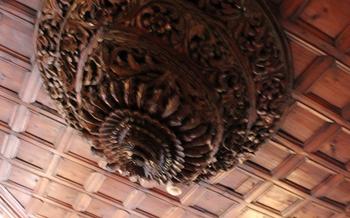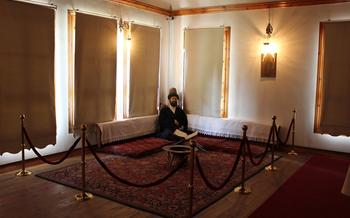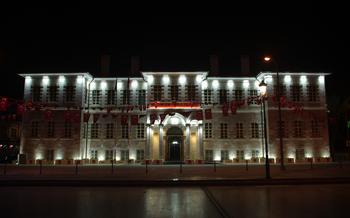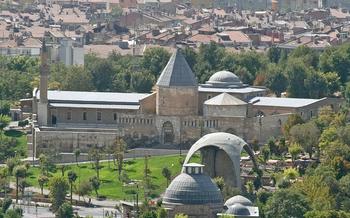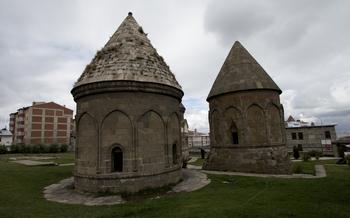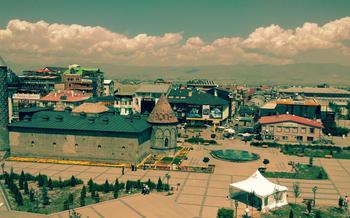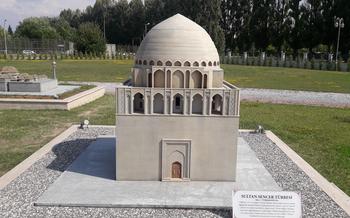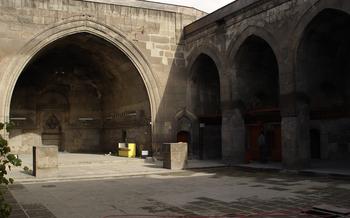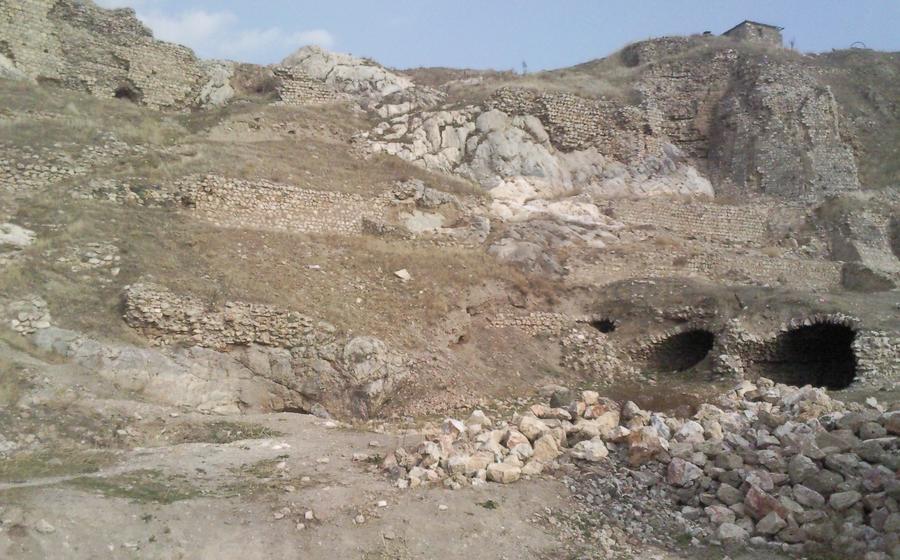
Birgi Cakiraga Mansion
- Birgi Cakiraga Mansion: A Hidden Gem in Tokat
- Exploring the Grand Courtyard
- Admiring the Seljuk-inspired Architecture
- Discovering the Winter and Summer Rooms
- Exploring the Reception Hall
- Unveiling the Secret Passages
- Admiring the Decorative Elements:
- Experiencing Local Craftsmanship
- Strolling Through the Mansion's Gardens
- Discovering the Mansion's History
- Unveiling the Mansion's Role in Local Culture
- Taking a Guided Tour: Unveiling the Secrets of the Birgi Cakiraga Mansion
- Attending Cultural Events
- Insider Tip: Hidden Gem in the Mansion
Birgi Cakiraga Mansion: A Hidden Gem in Tokat
In the heart of Tokat, nestled amidst cobblestone streets and historic landmarks, lies a hidden gem waiting to be discovered: the Birgi Cakiraga Mansion. This architectural masterpiece, dating back to the 18th century, stands as a testament to the region's rich history and cultural heritage. With its intricate carvings, grand courtyard, and hidden passages, the mansion offers visitors a glimpse into the opulent lifestyle of Tokat's elite during the Ottoman era.
The Birgi Cakiraga Mansion is a testament to the region's architectural prowess. Its design showcases a harmonious blend of Seljuk and Ottoman influences, with intricate carvings adorning its facades and grand arches framing its entrances. The mansion's spacious courtyard, surrounded by elegant structures, invites visitors to explore its many hidden corners, each revealing a new story from the past.
Exploring the Grand Courtyard
The grand courtyard of the Birgi Cakiraga Mansion is a testament to the architectural ingenuity and grandeur of the past. Designed as the central gathering space, the courtyard features a symmetrical layout adorned with intricate details and surrounding structures that reflect the diverse functions of the mansion.
The courtyard is paved with smooth stone slabs, creating a seamless expanse that invites visitors to wander and explore. At its center stands a majestic fountain, surrounded by colorful flower beds and fragrant shrubs, adding a touch of tranquility to the bustling space.
The surrounding structures include the main living quarters, guest rooms, and service areas, each with its own unique design and purpose. The main living quarters, located at the far end of the courtyard, are adorned with decorative facades, arched doorways, and ornate windows, hinting at the opulence within.
Smaller structures, such as the stables, storage rooms, and kitchens, are located on the sides of the courtyard, ensuring easy access and efficient movement of goods and personnel. These structures, though less elaborate in design, still showcase the attention to detail and craftsmanship that characterizes the entire mansion.
The courtyard served as a central hub for the daily life of the mansion's inhabitants. It was a place for residents to gather, socialize, and conduct business. The open and airy design allowed for ample natural light and ventilation, creating a comfortable and welcoming environment for all.
Admiring the Seljuk-inspired Architecture
The Birgi Cakiraga Mansion proudly exhibits the influence of Seljuk architecture, seamlessly blending Islamic design elements with traditional Anatolian craftsmanship. Its intricate carvings, geometric patterns, and graceful arches pay homage to the rich artistic legacy of the Seljuk Empire. The mansion's facade boasts stunning stonework, featuring intricate arabesque motifs and elegant calligraphy, reflecting the grandeur and sophistication of Seljuk architecture.
Inside the mansion, visitors can marvel at the harmonious integration of Seljuk design elements throughout its various spaces. The central courtyard, with its elegant arches and decorative tiles, evokes a sense of serenity and grandeur. The reception hall, adorned with intricate stuccowork and vibrant colors, showcases the opulence and artistry of the Seljuk era. Each room within the mansion reveals unique Seljuk-inspired features, from the delicate carvings on the wooden doors to the intricate patterns on the ceilings.
The Birgi Cakiraga Mansion stands as a testament to the enduring legacy of Seljuk architecture in Turkey. Its skillful blend of Islamic motifs and Anatolian craftsmanship creates a captivating visual experience, transporting visitors back to a time of cultural and artistic flourishing.
Discovering the Winter and Summer Rooms
In the Birgi Cakiraga Mansion, a fascinating feature is the presence of separate winter and summer rooms, each designed to cater to the specific needs of different seasons. The winter rooms, with their thick walls and small windows, were built to provide insulation and warmth during the harsh winter months. These rooms often had fireplaces or heating systems to ensure a comfortable temperature. The summer rooms, on the other hand, were designed to offer a cool and airy environment during the hot Turkish summers. They typically featured larger windows and higher ceilings to promote natural ventilation. These seasonal rooms showcase the mansion's adaptability to the changing climate and reflect the importance of comfort and livability in Ottoman architecture.
Exploring the Reception Hall
The reception hall stands as a testament to the grandeur and hospitality of the Birgi Cakiraga Mansion. Upon entering, visitors are greeted by an awe-inspiring space that exudes both elegance and functionality. The hall's spacious layout allows for seamless movement and interaction, while its intricate design elements captivate the eye.
The walls are adorned with exquisite tilework and carvings that showcase intricate patterns and motifs. These decorative elements draw inspiration from Islamic art and architecture, adding a touch of cultural heritage to the space. The ceiling, a masterpiece in itself, features a stunning chandelier that illuminates the hall with a warm glow, creating an inviting atmosphere.
Comfortable seating arrangements, arranged strategically around the hall, invite guests to relax and engage in meaningful conversations. These seating areas are adorned with plush cushions and intricate fabrics, reflecting the refined taste and comfort that the mansion's inhabitants enjoyed.
The reception hall served as a central gathering point for guests and visitors, where they were welcomed and entertained. It provided a space for social interactions, celebrations, and the exchange of ideas, highlighting the mansion's role as a hub of cultural and social activity.
Unveiling the Secret Passages
Intriguing hidden passages, a testament to the mansion's enigmatic history, wind their way through the Birgi Cakiraga Mansion. These secret routes, concealed within the mansion's walls, served practical and strategic purposes. In times of danger, they provided a safe escape route for the mansion's inhabitants, allowing them to discreetly navigate through the property unseen.
The architectural design of these passages is a marvel of ingenuity. Constructed with concealed entrances and intricate turns, they were designed to confuse and deter intruders. The passages also feature strategically placed ventilation systems, ensuring a continuous flow of fresh air for those using them.
Stories and legends surrounding these secret passages have captivated the imaginations of visitors for generations. Tales of daring escapes, hidden treasures, and clandestine meetings add an air of mystery to the mansion's allure. As you explore these hidden pathways, let your imagination run wild, picturing the clandestine activities that may have taken place within their shadows.
Admiring the Decorative Elements:
The Birgi Cakiraga Mansion is a treasure trove of intricate carvings and ornaments that showcase the artistic prowess of its creators. These decorative elements are not merely embellishments but carry deep symbolism and meaning, reflecting the cultural influences that have shaped the region.
The facade of the mansion is adorned with intricate stone carvings, each one a masterpiece of craftsmanship. Geometric patterns, floral motifs, and verses from the Quran intertwine in a harmonious display of Islamic art. The interior walls are adorned with vibrant frescoes and paintings, depicting scenes from history and mythology. These murals bring the mansion's stories to life, offering a glimpse into the past.
The ceilings of the mansion are adorned with stunning woodwork, featuring intricate carvings and inlaid mother-of-pearl. The designs range from geometric patterns to floral motifs, creating a sense of awe and wonder. The doors and windows are embellished with intricate metalwork, showcasing the skill of the local artisans. The intricate designs and patterns on these elements are not just decorative but also have symbolic meanings, representing different aspects of Turkish culture and history.
Exploring the Birgi Cakiraga Mansion is a journey through time and culture, where every decorative element tells a story. These intricate carvings and ornaments are a testament to the artistic heritage of Tokat and the enduring legacy of the Cakiraga family.
Experiencing Local Craftsmanship
Birgi Cakiraga Mansion offers a unique opportunity to witness and learn about traditional Turkish craftsmanship. The mansion regularly hosts demonstrations of various crafts, providing visitors with an immersive experience into the rich cultural heritage of Tokat. From intricate woodcarving and pottery to traditional weaving and embroidery, visitors can witness the skill and artistry of local artisans firsthand.
Workshops and classes are also available for those who wish to learn these traditional crafts themselves. Under the guidance of experienced artisans, visitors can try their hand at creating their own unique pieces of art, taking home a cherished souvenir that reflects the beauty and craftsmanship of Tokat. These workshops provide an opportunity for cultural exchange and understanding, allowing visitors to connect with the local community and gain a deeper appreciation for Turkish culture.
Preserving and promoting cultural heritage are at the heart of these initiatives. The mansion, with its commitment to showcasing traditional crafts, plays a vital role in ensuring that these skills and techniques are passed down to future generations. By participating in demonstrations and workshops, visitors contribute to the preservation of this precious cultural heritage while simultaneously supporting the local artisans who keep these traditions alive.
Strolling Through the Mansion's Gardens
As you step out of the mansion's opulent interiors, a refreshing haven awaits you—the serene gardens that envelop the Birgi Cakiraga Mansion. Lush greenery, vibrant flowers, and towering trees create a picturesque landscape that invites you to wander and soak in the tranquil atmosphere.
The gardens, meticulously manicured and adorned with intricate pathways, offer a serene escape from the bustling city. Stroll along the cobblestone paths, inhaling the sweet fragrance of blooming roses and jasmine. Let the gentle breeze rustle the leaves of ancient trees as you admire the vibrant colors that paint the landscape.
Pause for a moment to rest on one of the many benches scattered throughout the gardens, immersing yourself in the peaceful surroundings. Listen to the soothing sounds of birdsong and the gentle trickling of water from the nearby fountains, allowing your mind to unwind and reconnect with nature.
In the heart of the gardens, discover a hidden gem—a secluded gazebo adorned with climbing ivy and fragrant flowers. Take a seat within this enchanting retreat and savor the tranquility of your surroundings. Let the beauty of nature wash over you as you contemplate the rich history and charm of the Birgi Cakiraga Mansion.
Whether you seek a moment of solitude or a leisurely stroll, the gardens of the Birgi Cakiraga Mansion offer a sanctuary of peace and tranquility, inviting you to lose yourself in the embrace of nature's beauty.
Discovering the Mansion's History
The Birgi Cakiraga Mansion stands as a testament to the rich history of Tokat and the enduring legacy of the Cakiraga family. Delving into the mansion's past reveals a captivating narrative of construction, evolution, and cultural significance.
The mansion's foundations were laid in the 18th century by the prominent Cakiraga family, who played a pivotal role in shaping the city's history. Over the centuries, the mansion underwent several renovations and expansions, reflecting changing tastes and evolving needs. Each addition and alteration added a unique layer to the mansion's character, resulting in a harmonious blend of architectural styles and influences.
As the Cakiraga family prospered, the mansion became a hub of social and cultural activity. It hosted lavish gatherings, weddings, and celebrations, showcasing the family's wealth and influence. The mansion's grandeur and opulence became legendary, attracting visitors from far and wide.
Throughout its existence, the mansion has witnessed countless events and transformations. It has survived wars, economic downturns, and political upheavals, emerging as a symbol of resilience and continuity. Today, it stands as a testament to the enduring spirit of Tokat and its people.
By exploring the mansion's history, visitors gain a deeper appreciation for its significance and the role it has played in shaping the city's identity. It is a journey through time, revealing the stories of the people who lived within its walls and the events that shaped its destiny.
Unveiling the Mansion's Role in Local Culture
The Birgi Cakiraga Mansion holds a significant place in the cultural tapestry of Tokat. Throughout history, the mansion has served as a venue for various cultural events and gatherings, contributing to the city's vibrant cultural scene. Prominent figures from the worlds of art, literature, and politics have graced the mansion's halls, engaging in intellectual discussions and artistic performances.
The mansion's unique architectural features and historical significance make it an ideal setting for cultural events. Concerts, exhibitions, and workshops frequently take place within its walls, showcasing the talents of local artists and artisans. These events provide a platform for cultural exchange and promote the preservation of traditional Turkish arts and crafts.
The mansion's role in preserving and promoting local traditions is of utmost importance. It serves as a repository of Tokat's rich cultural heritage, housing a collection of artifacts and documents that tell the story of the city's past. The mansion's gardens are also a venue for traditional festivals and celebrations, where locals and visitors come together to experience the vibrant customs and folklore of the region.
The Birgi Cakiraga Mansion is more than just a historical monument; it is a living testament to Tokat's cultural identity. By hosting cultural events and preserving local traditions, the mansion plays a crucial role in fostering a sense of community and pride among the people of Tokat. It is a place where history, culture, and community converge, creating a vibrant and dynamic space that enriches the lives of all who experience it.
Taking a Guided Tour: Unveiling the Secrets of the Birgi Cakiraga Mansion
Immerse Yourself in History with Expert Guidance
Enhance your visit to the Birgi Cakiraga Mansion by taking advantage of the guided tours offered in various languages. Led by knowledgeable and passionate guides, these tours provide an immersive and informative experience that allows you to delve deeper into the mansion's rich history and significance.
Unravel the Stories Behind Every Corner
As you wander through the grand halls and intimate chambers, your guide will regale you with captivating tales of the Cakiraga family, the mansion's construction, and the events that have unfolded within its walls over the centuries. Discover the hidden meanings behind the intricate carvings, the symbolism of the decorative elements, and the stories associated with the secret passages.
Gain a Deeper Understanding of Tokat's Heritage
The Birgi Cakiraga Mansion is not just a historical monument but also an integral part of Tokat's cultural fabric. Your guide will provide insights into the mansion's role in shaping the city's identity, its influence on local traditions, and the cultural events and gatherings that have taken place within its walls.
Experience the Mansion through the Eyes of an Expert
With a guided tour, you'll gain a deeper appreciation for the architectural marvels, the craftsmanship, and the cultural significance of the Birgi Cakiraga Mansion. Your guide will ensure that you don't miss any hidden gems or intriguing details, allowing you to fully immerse yourself in the mansion's captivating history and charm.
Attending Cultural Events
Birgi Cakiraga Mansion is not just a historical site but also a vibrant cultural hub. Throughout the year, the mansion hosts a variety of cultural events and festivals that showcase the rich heritage and traditions of Tokat. From traditional music concerts and dance performances to art exhibitions and workshops, there's always something exciting happening at this cultural gem.
Attending these events is an excellent opportunity to experience the local culture firsthand and gain a deeper understanding of the region's history and traditions. Immerse yourself in the mesmerizing rhythms of traditional Turkish music, marvel at the grace and agility of local dancers, or explore the intricate details of handcrafted artworks.
One of the highlights of the cultural calendar is the annual Birgi Cakiraga Mansion Festival, which takes place during the summer months. This vibrant festival brings together local artisans, musicians, and performers, creating a lively atmosphere filled with music, dance, and traditional crafts.
Whether you're a history buff, a culture enthusiast, or simply looking for a unique and enriching experience, attending cultural events at Birgi Cakiraga Mansion is a must-do. Check the mansion's official website or inquire with local tourism offices for upcoming events and festival dates to plan your visit accordingly.
By participating in these cultural events, you'll not only enhance your visit to the mansion but also contribute to the preservation and promotion of Tokat's rich cultural heritage.
Insider Tip: Hidden Gem in the Mansion
Beyond the main attractions, the Birgi Cakiraga Mansion holds a secret that few visitors know about. Tucked away in a secluded corner of the mansion, there is a hidden room that has been forgotten by time. This room, once used as a private chamber, is now a treasure trove of history and intrigue. Its walls are adorned with intricate carvings and colorful frescoes, depicting scenes from the mansion's past. Visitors who stumble upon this hidden gem will be transported back in time, experiencing the grandeur and opulence of a bygone era.
As you explore the mansion, keep an eye out for clues that may lead you to this secret room. Perhaps a discreetly placed door or a hidden passageway will reveal its entrance. Discovering this hidden treasure will add an element of excitement and adventure to your visit, making your experience at the Birgi Cakiraga Mansion truly unforgettable.

